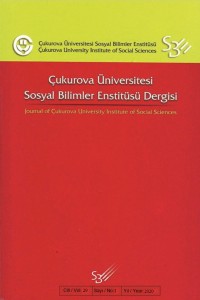Öz
In today's competitive world, companies should minimize cost while providing high quality goods. Companies generally try to reduce the level of inventory to minimize the cost and therefore they usually observe shortage in practice. At this point, using of the right inventory control policy is the most effective and efficient way to reduce shortage. In inventory control policies, the basic question is to specify the size and the timing of a replenishment order in supply chain members. Over the years, many advanced methods have been applied to answer these questions. Due to the difficulty of dealing with the uncertainties in supply chain environment, simulation optimization (SO) is used in this study to get the application of goals in supply chain. Although SO requires a great deal of understanding related with inventory control system, the use of SO brings such complex system within the grasp of managers. In this paper, SO is used to analyze the supplier selection and inventory control system simultaneously. The system results clearly reveals that the best values of inventory control variables and the most suitable suppliers can be determined by SO in a two echelon supply chain model with backorder.
Anahtar Kelimeler
Simulation Optimization Inventory Control System Supplier Selection
Kaynakça
- Abuizam, R. (2011). Optimization of (s, S) periodic review inventory model with uncertain demand and lead time using simulation. International Journal of Management and Information System, 15(1), 67–80. Bensoussan, A., Çakanyıldırım, M., Minjarez-Sosa, J. A., Sethi, S. P., & Shi, R. (2010). An incomplete information inventory model with presence of inventories or backorders as only observations. Journal of Optimization Theory and Applications, 146(3), 544–580. Cárdenas-Barrón, L. E. (2011). The derivation of EOQ/EPQ inventory models with two backorders costs using analytic geometry and algebra. Applied Mathematical Modelling, 35(5), 2394–2407. Chen, J., Huang, S., Hassin, R., & Zhang, N. (2015). Two backorder compensation mechanisms in inventory systems with impatient customers. Production and Operations Management, 24(10), 1640–1656. Chung, K-J., & Cárdenas-Barrón, L. E. (2012). The complete solution procedure for the EOQ and EPQ inventory models with linear and fixed backorder costs. Mathematical and Computer Modelling, 55(11-12), 2151–2156. Göçken, M., Dosdoğru, A. T., Boru, A., & Geyik, F. (2017). Characterizing continuous (s, S) policy with supplier selection using Simulation Optimization.Simulation, 93(5), 379–396. Gurgur, C. Z., & Altiok, T. (2008). Decentralized multi-product multi-stage systems with backorders. IIE Transactions, 40(3), 238–251. Haq, A. N., & Kannan, G. (2006). Design of an integrated supplier selection and multi-echelon distribution inventory model in a built-to-order supply chainenvironment. International Journal of Production Research, 44(10), 1963–1985. Jaggi, C. K., & Arneja, N. (2011). Application of Chebyshev inequality in stochastic inventory model with controllable lead time and backorder discount. International Journal of Inventory Control & Management, 1(1), 13–28. Jalali, H., & Nieuwenhuyse, I. V. (2015). Simulation optimization in inventory replenishment: a classification. IIE Transactions, 47(11), 1217–1235. Jawahar, N., Gunasekaran, A., & Balaji, N. (2012). A simulated annealing algorithm to the multi-period fixed charge distribution problem associated with backorder and inventory. International Journal of Production Research, 50(9), 2533–2554. Johansson, L., & Olsson, F. (2017). Quantifying sustainable control of inventory systems with non-linear backorder costs. Annals of Operations Research, 259 (1-2), 217–239. Johansson, L., & Olsson, F. (2018). Age-based inventory control in a multi-echelon system with emergency replenishments. European Journal of Operational Research, 265(3), 951–961. Kok, A. G. (1993). Backorder lead time behaviour in (s, Q)-inventory models with compound renewal demand. (Memorandum COSOR; Vol. 9333). Eindhoven: Technische Universiteit Eindhoven. Mart, T., Duran, S., & Bakal, İ. S. (2013). Tactical inventory and backorder decisions for systems with predictable production yield. International Journal of Production Economics, 143(2), 294–303. Mercado, E. C. (2008). Hands-on inventory management. Taylor & Francis Group, LLC. Pegden, C. D. (2007). SIMIO: a new simulation system based on intelligent objects. In: Winter Simulation Conference, Washington, DC, 2293–2300. Rabbani, M., Oliaei, M. T. B., Farrokhi-Asl, H., & Mobini, M. (2017). A new mathematical model in cell formation problem with consideration of inventory and backorder: Genetic and particle swarm optimization algorithms. Iranian Journal of Management Studies, 10, 819–852. Rad, M. A., Khoshalhan, F., & Glock, C. H. (2014). Optimizing inventory and sales decisions in a two-stage supply chain with imperfect production and backorders. Computers & Industrial Engineering, 74, 219–227. Rogers, D. F., & Tsubakitani, S. (1991). Newsboy-style results for multi-echelon inventory problems: backorders optimization with intermediate delays. Journal of the Operational Research Society, 42(1), 57–68. Santis, R. B., de Aguiar, E. P., & Goliatt, L. (2017). Predicting material backorders in inventory management using machine learning. In: IEEE Latin American Conference on Computational Intelligence (LA-CCI), Arequipa, 1–6. Samouei, P., Kheirkhah, A. S., & Fattahi, P. (2015). A network approach modeling of multi-echelon spare-part inventory system with backorders and quantity discount. Annals of Operations Research, 226, 551–563. Sarker, B. R., Rochanaluk, R., & Egbelu, P. J. (2014). Improving service rate for a tree-type three-echelon supply chain system with backorders at retailer's level. Journal of the Operational Research Society, 65, 57–72. Srivastav, A., & Agrawal, S. (2016). Multi-objective optimization of hybrid backorder inventory model. Expert Systems with Applications, 51, 76–84. Tripathi, M., Kuriger, G., & Wan, H. (2009). An ant based simulation optimization for vehicle routing problem with stochastic demands. In: Proceedings of the 2009 Winter Simulation Conference (WSC), Austin, TX, USA, 2476–2487. Yao, Y., Dong, Y., & Dresner, M. (2010). Managing supply chain backorders under vendor managed inventory: An incentive approach and empirical analysis. European Journal of Operational Research, 203(2), 350–359. Zhang, G. P., Patuwo, B. E., & Chu, C-W. (2003). A hybrid inventory system with a time limit on backorders. IIE Transactions, 35(7), 679–687.
Ayrıntılar
| Birincil Dil | İngilizce |
|---|---|
| Bölüm | Makaleler |
| Yazarlar | |
| Yayımlanma Tarihi | 20 Nisan 2020 |
| Gönderilme Tarihi | 5 Aralık 2018 |
| Yayımlandığı Sayı | Yıl 2020 Cilt: 29 Sayı: 1 |


